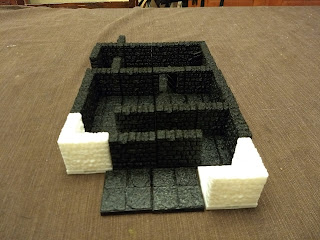I've printed some other dungeon tile sets and there are things I like about Dragonlock.
The tiles are well-designed. 3d printing files that can be printed cleanly and easily make your life as a hobbyist printer much simpler. The more adjusting you need to do, the less likely you'll print the file. These are easy to print and get consistent results.
They look good! These are well-designed tiles that mimic the look of Dwarven Forge and other manufactured tiles.
The tiles have a nice weight. They feel sturdy and substantial which makes it easier to move them around confidently.
The clips for the tiles hold things together tightly and come apart easily when pulled. In previous tile sets, the clips have been the thing to do me in. These have easy ports for attaching and removing clips. The clips themselves are easy to print and use.
There is a drawback to Dragonlock as well.
Other tile sets I have printed have had separate walls and floors. This allows for better use of the full tile; a Dragonlock wall tile uses up 1/2 of a 5-foot square for the wall. I like the idea of having a full tile instead of a half, but there is an advantage to an attached wall. It makes your life SO MUCH EASIER when you want to lay out a new dungeon floor, which is why you want to use these tiles.
If you can't easily set them up, you won't.
Having done just a few basic layouts, I feel like I've gotten around the wall problem in most cases. You just have to practice laying things out so you don't have double walls or missing spaces. Dungeon rooms may need to be slightly bigger than usual, or you account for the half-tile on each side, making a full tile in the end.
3d printing makes for a very nice quality of dungeon. For fast things and lots of variety in terrain type, I still like making simple cardboard tiles. This is something I've done for a long time and still love the ease/look of as well.
Hand making cardboard tiles is a lot faster than 3d printing. I can break down a box and make floor tiles very fast; printing the 3d tiles in the picture above has taken about a week of casual overnight printing.
If you're interested in 3d printed tiles to make a dungeon, I would recommend Dragonlock by Fat Dragon Games. These are the easiest and cleanest dungeon tiles I've printed yet. If you like cardboard too, you can probably make a set of cardboard tiles for a whole dungeon in the time you print 3 Dragonlock walls. Use those to prototype or for small scenes and save the 3d printed tiles for a grand occasion.


Comments
Post a Comment